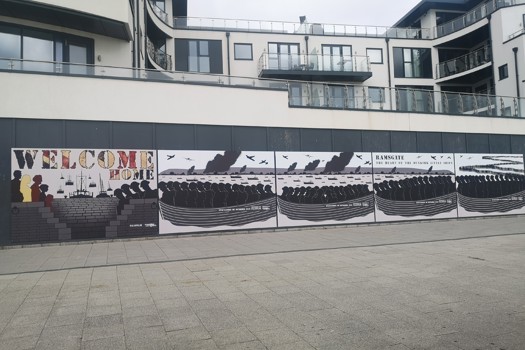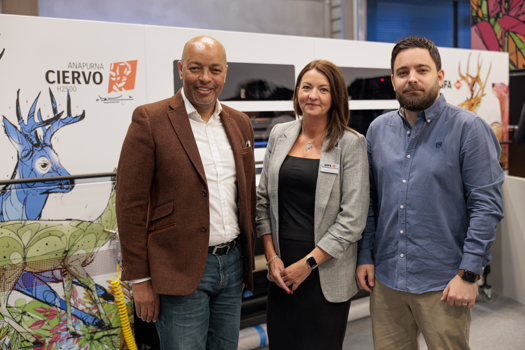"You can’t use roadsigns or most other direction signs. No printed ceramic tableware and certainly not credit cards or banknotes. So you’re confined to coins.”
This is how PrintWeek technology guru Simon Eccles’ email starts to me one otherwise fairly unremarkable day in the office. Not, most would agree, the kind of correspondence you’d usually expect from a (non-Amish) industry peer or colleague.
And there’s more bad news coming my way. “Clock and watch faces might be out,” Eccles informs me, the mental image of myself and him donning white bonnets and turn-of-the-century waistcoats growing stronger by the minute. “And bulbs and the like often have printed CE and wattage marks.”
Turns out, living for a day without print could be tough. And dark.
“Well, that’ll be a lovely celebration of print’s power,” I’d thought, merrily scheduling the feature in some weeks before, imagining me waxing lyrical (read: showing off my incredibly literary tastes) about my love of the printed word.
Not that I’d thought it would be a walk in the park. Finding food that wasn’t in printed packaging would of course be tricky. And I was vaguely aware there might be some unexpected things I couldn’t do. I just hadn’t realised not bumping into stuff between the hours of 4pm and 8am would be one of them.
It gets worse. “What about printed electronics and the print on your laptop keys?” PrintWeek’s (usually) delightful Jo Francis pipes up. “Ooh and textiles too,” she chirps, helpfully.
It’s time, I realise as I make a disgruntled mental note to cancel all engagements – or at least enquire about my friends’ feelings on sitting in a carefully prepared, foodless, unfurnished room – to ask the experts.
First stop: Magnus Mighall, owner of RA Smart textile printer and textile printing kit supplier. “In the typical home, we can probably go through every room and discover a lot would have been printed,” he says. “Starting off in the kitchen, you’ve got aprons, tea towels, oven gloves, blinds.”
“It’s very unlikely you’re not going to have a substantial amount of print in your wardrobe,” continues Mighall. He informs me that patterned tights and sports kit with printed logos (one silver lining at least), are out. And breaks the news that with only around 30% of soft furnishings plain dyed, my bed linen, cushions, and – somewhat solving the light bulb conundrum I suppose – curtains, are also out.
Brighter outlook
My conversation with Steve Jones, business development director at Printed Electronics, starts slightly more hopefully. “If you Google ‘printed electronics’ you’ll get millions of hits so there’s a lot of interest,” he says. “But on a daily basis you won’t actually see very much of it because it’s still at a latent stage.”
Jones explains that this is because most electronics are made so cheaply in China, by etching a circuit into a copper-clad piece of material, that the high cost of printing electronics here can’t compete.
“So instead of competing with traditional electronics, because we can’t, we look at putting it where it wasn’t before,” says Jones, explaining that this means I’m most likely to come across printed electronics (if I’m very unlucky) in the form of musical socks and greetings cards.
“If you buy a Duracell battery and press the button to see whether it’s full, that’s printed electronics. Then there’s some labels on upmarket drinks and printed electronics in the spines of magazines to create moving cover images,” he continues, adding that some cars and aeroplanes also use printed sensors to monitor the health of suspension systems. “Chances are you’ll be fine using transport, unless you’ve got a McLaren sat in the garage.”
Clearly Jones is responding to the James Bond-esque air I tend to impress on people. He goes on to inform me that making calls in special, hacking-proof rooms is also out. “We print wallpaper with special antennas in it that can either stop people phoning out, or stop them tapping into phone conversations being made inside,” he reports. “A lot of government buildings have those kinds of rooms. You can talk through them, someone’s voice isn’t affected, but the very high frequencies of let’s say radio waves or 3G, can’t pass through.”
So no novelty socks, flash sports cars or hanging out at high-security government locations. Got it.
But then Jones drops the bombshell. While the circuitry of my phone might not be printed, chances are the membrane just under the screen is. “Every smartphone’s display uses what’s known as OLED technology. Your phone has a nice crisp display because it’s got a membrane that’s been inkjet printed with RGB dots with phosphors in the inks. There’s a little electric field applied to that which lights them up.”
So a day without using my laptop or smartphone, or reading. Unsurprisingly such an unenticing Saturday starts with a lie-in. ‘Not so important now are you print,’ I think smugly, going in for the fourth snooze.
But then hunger strikes, and I’m forced to start thinking about sourcing non-packaged food. Possibly Ray Mears-style.
Payment is my first quandary. I definitely haven’t enough coinage for a day’s worth of food and bus fare (using my Oyster travel card is of course out). And the idea of people turning around in alarm at the sound of my approaching with £20-worth of angrily jangling change, doesn’t fill me with joy. So I decide, stomach rumbling, to investigate mobile phone payment.
Though this is technically cheating according to Printed Electronics’ Jones’ strict definition of print (in fact doubly so – Jones has also informed me that NFC-ready phones have a printed aerial, typically on their batteries, which allow their NFC chips to be activated), it does seem the most likely way folk will do without traditional print in future. One day, afterall, we won’t think twice about doing everything, from ordering coffee to catching up on the news, using, possibly implanted, gadgets and gizmos. It’s the future.
That as it may be, it certainly doesn’t seem to be the present. Googling on my laptop (yes, half an hour in and I’m already infringing multiple rules), which app I should download, and I’m soon drowning in a sea of often contradictory information. There are many options but no clear, trustworthy winner. And many apps either don’t seem available yet full stop, or, like Google Wallet, aren’t available in the UK.
Payments postponed
My research reveals others to be similarly sceptical. A 2014 Mobile Payments State of the Industry Report recently found that still only 25% of consumers had ever paid using their mobile in a bricks-and-mortar store.
“It will certainly never be the case that everyone does it, it would take a huge generation shift of maybe 100 years or so,” says PrintWeek’s regular digital technology writer Dan Watson, when I call in a slightly desperate state. “The banks are going to be the catalysts for this. But then you hit other issues like Apple not having NFC on their phones – and they possibly never will. And the number of stores that offer this is still pretty limited. And many just don’t feel confident this is secure.”
People, then, apparently still love paying with print. And it turns out this research is redundant for me anyway. A quick call to Samsung reveals that I’m too much of a Luddite for this technology. My smartphone, being two years old, doesn’t have an NFC chip. My stomach growls.
So swallowing my pride and scraping together coinage from flatmates it is. Not that this helps me in Tesco’s. A quick reccy reveals only two print-less items: bananas and coriander. A delicious combo.
The local market is more, well, fruitful. Fruit, veg and even eggs are pretty easy to come by in plain packaging (though I notice later that my eggs have product codes printed on the shells. Fail). But carbs – what my stomach is angrily demanding now – prove tricky.
“They’re ragaicnajuh beans,” a stall owner says briskly as I hold up a clear plastic bag full of unfamiliar, mysterious-looking beans. “Rahidnjskknag beans,” he says impatiently. And, awkward Brit through and through, I promptly buy said beans and scarper home to cook.
With limited success. With no cooking, nevermind serving, suggestions on the pack to guide me, and no way of Googling even a food name, I resort to boiling. Then I resort to throwing the curiously mushy and crunchy mess in the bin.
I also decide against trying the mysterious purplish contents of the only non-printed packaged item I can find in the house. It looks like it could be pickled beetroot. But then probably so does most veg if left long enough in a jar...
Next task: de-print my room. Not the most fun of tasks; my room resembles a rather down-market hotel room once I’ve taken my postcards, photos and posters down. But at least it kills some time.
Which is more than can be said for the other activities – namely tidying my room and annoying my flatmates – I listlessly try to fill the rest of my day with.
So what finally cracks me? The call of my laptop, printed keys and all? The copy of The Golden Notebook I’d been meaning (but let’s be honest, failing) to start for a while? The draw of cooking a meal using a normal range of ingredients?
No. Embarrassingly not.
I’ll give you a clue. It may or may not have been a publication typically including five stories per issue on Harry Styles’ hair. Its title may or may not mean the opposite of ‘cold’.
Heat: what a way to cave in. But it does show, whatever the future holds for bank-notes and bank cards, books and printed textiles (and my day would suggest good things), there’s one thing that will always endure. The lure of a ‘ring of shame’ article, in all its glossy glory, is innate.
Resistance is futile. Long live print.










